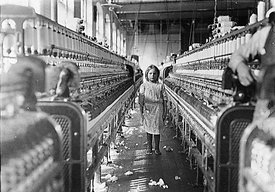Child labor
|
|
| Articles related to the Labor movement |
| Child labor |
| Labor in economics |
| Labor history |
| Labor law |
| Labor rights |
| Labor union |
| Strike |
| Edit this template (http://en.wikipedia.org/w/wiki.phtml?title=Template:Labor&action=edit) |
Child labour or labor is the phenomenon of children in employment. In some countries, it is considered inappropriate or exploitative if a child below a certain age works, except for some household chores and of course school work. An employer is often not allowed to hire a child below a certain age. This minimum age depends on the country.
Other forms of work include helping in the parents' business or having one's own small "business", like cleaning car windows, shining shoes, selling small items such as cigarettes, etc. Some children work as a guide for tourists, sometimes combined with working for owners of shops and restaurants, bringing tourists to these businesses. Also there is military use of children, child prostitution and illegal drug trade, illegal trade involving copyright violations (CDs, CD-ROMs, etc.) and there are child actors and child singers.
ChildLabor1910.png
The voluntarism of such work may vary greatly, but even if a child says he or she wants to work (e.g. because the earnings are attractive or if the child hates school) it may still be an undesirable situation for the child in the long run.
The use of children as laborers is now considered by wealthy countries as a human rights violation, and outlawed, while poorer countries may allow it, as families often rely on the labors of their children for survival and sometimes it is the only source of income.
The term child labor can have a connotation of systematic exploitation of children for their labor, with little compensation nor consideration for their safety, or health.
International concern has recently been raised in regard to an implied moral complicity of the buying public with child exploitation, through the purchase of products assembled or otherwise manufactured with child labor. However, some express concerns that boycotting products manufactured through child labor may force these children to turn to more dangerous professions due to necessity, such as prostitution or agriculture. For example, a UNICEF study found that that 5,000 to 7,000 Nepalese children turned to prostitution after the U.S. banned that country's carpet exports in the 1990s. Also, after the Child Labor Deterence Act was introduced in the US as estimated 50,000 children were dimissed from their garment industry jobs in Bangladesh, leaving many to resort to jobs such as "stone-crushing, street hustling, and prostitution," --"all of them more hazardous and exploitatitive than garment production" according to a UNICEF study. [1] (http://www.unicef.org/sowc97/)
Individuals, corporations, nations, and other entities can often be active in a deliberate, systematic, use of children for their labor, while others will ignore such abuse.
In the west, during the Industrial Revolution, use of child labour was commonplace, often in factories. In the United Kingdom during the Victorian era, a series of Factory Acts were passed to gradually restrict the hours that children were allowed to work, and to improve safety. The United States also has extensive child labor laws.
Related articles
International Conventions and other Instruments:
- Convention on the Rights of the Child
- Worst Forms of Child Labour Convention
- Worst Forms of Child Labour Recommendation
Types of Programmes focussing on Child Labour
Country-specific programmes:
External links
- Teaching about Child Labor and International Human Rights (http://www.ericdigests.org/2003-5/rights.htm)
- Child Labor in Agriculture (http://www.ericdigests.org/1997-4/labor.htm)
- History Place (http://www.historyplace.com/unitedstates/childlabor/) Photographs from 1908-1912
- Ethical and economic considerations in child labor (http://samvak.tripod.com/childlabor.html)
- Child Labor or Prostitution? (http://www.cato.org/dailys/10-08-02.html)
- Ending Child Labour — Bans Aren’t the Solution (http://64.233.179.104/search?q=cache:_AFraRNnwLMJ:www.fraserinstitute.ca/admin/books/chapterfiles/Mar05ffchildlab.pdf)
- The State of the World's Children - a UNICEF study (http://www.unicef.org/sowc97/)
af:Kinderarbeid de:Kinderarbeit fr:Travail des enfants nl:Kinderarbeid pt:Trabalho infantil

